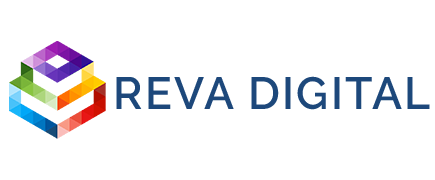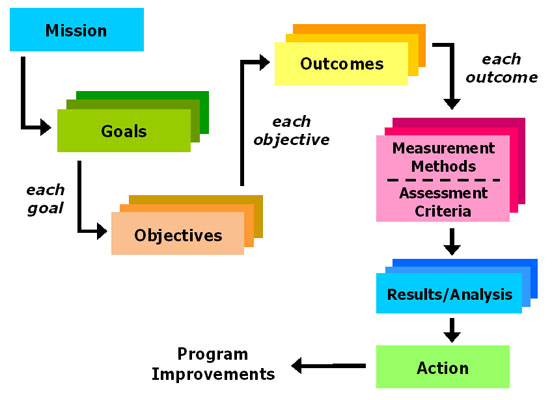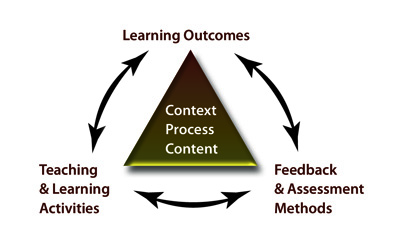Corporate learning outcomes are essential to designing a successful training program. A corporate learning outcome is a statement of what employees of a given organization who are enrolled in a given program are expected to accomplish and be able to do successfully upon the completion of the program. It’s important for every training department to prepare a learning outcome statement for which it can measure the success or failure of any learning program it initiates. Without a clear statement of expected outcomes, measuring the success or failure of any learning activity within the organization is complicated.
Figure 1: Outcomes Assessment Plan
Source: Allen 2004
Why a Clear Learning Outcomes?
A clear learning outcome offers important guiding information to both potential training candidates and the organization (employer) on the training program and how best to approach the program for better results. The following are important reasons why you need to write clear learning outcomes before starting any corporate training program.
Learning outcomes help…
- offer guidance to learners on what is expected of them at the end of the program.
- employees taking part in a training program to focus more on the core skills, competencies and knowledge that they are required to achieve.
- staff and the learning program facilitators to make appropriate choices of teaching and learning strategies and methods.
- in developing appropriate learning monitoring program.
What to consider when writing learning outcomes:
A learning outcome is a statement that explains what is expected of a learner who takes part in a learning program. It gives the skills, knowledge and capabilities a learner is expected obtain by participating in a learning program. To write clear learning outcomes consider the following tips:
1. Be Realistic.
It is important to have learning outcomes that can be achieved within the set period of time for the program. Avoid being over ambitious and instead consider all the factors that will affect the process. Take into account important parameters such as the available time, the prior knowledge and the other available learning opportunities.
2. Ensure that the learning outcomes are measurable and observable.
Only come up with learning outcomes that can be measured and observed easily. It is important to develop learning outcomes that can be observed during and after the training program. Some learning outcomes may be difficult to quantify, however, if you craft explicit objectives, however, measuring success is possible.
3. Don’t write too learning outcomes that are too narrow or too broad.
Learning outcomes that are too broad in scope may pose problems with measurement and assessment, while those that are too narrow may not cover sufficient scope for the learning process. Ensure that you always have balanced learning outcomes.
4. Ensure that you are exact and concise at all times.
The learning outcome statement should state exactly what is expected of learners. It should thus be clear, direct, and to the point.
5. Use a simple language that the learners can understand.
Always use vocabularies the learners can understand. This is possible no matter how complex you may consider the topic to be, but may take some practice. It is important to write the learning outcome in a simple language so that learners can easily understand them as this supports their ability to work successfully towards the desired outcome. Remember, the learning outcome statements are made not only to guide the organization, but they are also meant to help individual learners.
6. Have a manageable number of learning outcomes.
For each corporate training program, it is important to develop a manageable number of learning outcomes. Ensure that the number of learning outcomes covers all the skills, but is not too large. This will make it easy to follow up and assess the learning process.
7. Have a number of open-ended learning outcomes to give room for creativity.
Creativity is important in any form of learning process. To allow for creativity it is important to develop a number of open-ended learning outcomes so that learners may follow their intuition and develop creative ideas for the organization.
Figure 2: Learning outcome in Course Design
Source: University of Guelph, 2015
Examples of Learning Outcomes:
Usually learning outcomes are framed in a form of a statement that start with the phrase: “Upon successful completion of this program the learner will…”
This phrase is usually followed by terms such as ‘understand’ or ‘know’, but avoid those terms when you can as it’s difficult to observe ‘understanding’ or ‘knowing’ in a meaningful way. Instead use terms like ‘be able to’ followed by verbs such as ‘build’, ‘compare’, ‘classify’,'”organize’, ‘identify’ or any other action that precisely represents the desired learning outcome. The following are example of quality learning outcomes:
- Upon successful completion of this program the learner will be able to confidently pursue, engage and resolve a number of technical building services engineering issues.
- On successful completion of this learning program the learner will be able to effectively work as a team member.
- Upon successful completion of this learning program, learners will be able to identify and critically asses effective on-line marketing strategies that the organization can explore
- Upon successful completion of this learning program, learners will be able to identify and analyze key management issues in the company and propose important solutions to these issues
The School of Public Health at the University of Washington provides this useful resource with verbs for writing learning outcomes.
Linking Your Learning Outcomes to the Program Assessment:
Learning outcome statements give the minimum expectations for the learners to achieve upon the completion of the program. An assessment method and criteria are required in order to measure the actual achievement of the learning outcomes. That said, not all training programs warrant traditional assessment, in fact, in many cases the desired outcome may be a change in behavior that is observed over time. The point is, some measurement will always be possible if the program is designed optimally. In business, and in academia, it is necessary for a training program to show a clear link between the learning objectives and the learning outcomes so that the organization can make intelligent business decisions around the training, and so the training can be improved over time. Ultimately, writing clear corporate learning outcomes will help your organization know how best to approach the program for better results.


